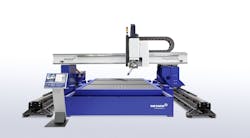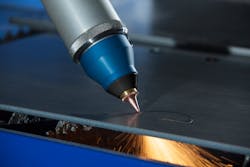Thanks to steady increases in laser power, the precision of laser cutting now benefits a wide range of applications, from fusion cutting of structural steel to faster and more efficient cuts of thinner materials. At Messer Cutting Systems, this is reflected in increasing reliance on high-performance fiber lasers for its cutting systems.
Messer Cutting Systems (Rödermark, Germany) is a global supplier of products and services for the metal processing industry. The company employs more than 800 people at its five main production sites. Products include oxyacetylene-, plasma-, and laser-cutting systems, ranging from handheld devices to special machinery for shipbuilding, as well as systems for oxyacetylene welding, soldering, and warming. The company conducts development projects on individual assemblies, software, and sensor technologies at the main facility, and then custom and market-specific development is finalized at local facilities.
Minimizing focus shift
When it comes to the development of new cutting systems, Messer knows that measurement technology plays a decisive role (FIGURE 1). According to Thomas Dünzkofer, project manager in development at Messer Cutting Systems, “Determining the focus shift, in particular, had been very time-consuming for us and it posed some risk when the lasers were of higher power. At the same time, we really needed those measurement results.”
Messer’s research team developed a new software algorithm that could be used to minimize the focus shift in their laser-cutting systems (FIGURE 2). It is based on time-resolved measurements specific to each type of cutting head.Noncontact beam measurement
The noncontact beam measurement system allows a laser beam to pass through an opening into the interior of the system and then exit the other side—without experiencing any impact along the way. It can do this because it measures Rayleigh radiation. This refers to the scattering of electromagnetic waves from particles smaller than the radiation's wavelength, such as oxygen or nitrogen molecules in the air. The electric field of the laser radiation induces an oscillation in the dipole molecule at the laser's frequency, leading to elastic scattering at that same frequency (see "Measuring a high-power laser with Rayleigh scatter").
Inside the instrument, the scattered laser light is imaged from the side using a telecentric lens assembly on a CCD or CMOS camera. Each individual pixel in a single line of the CCD camera detects the scattered light as a measuring point of intensity in the beam profile. When used with a standard CCD or CMOS camera with 1090 × 2048 pixels, the system will measure 2048 individual profiles simultaneously. From these measurements, the beam and beam-quality parameters can be calculated according to ISO-13694 and ISO-11146 standards.
For Messer, the speed of the system is critical. Measurements at video frame rates make it possible to see—for the first time—any shift in focus, which is especially liable to occur right after the laser is turned on. Dünzkofer stated, “When cutting with lasers of high power and short approach paths, a shift in focus can definitely affect the cutting process.” This is why the research team at Messer developed a software component for use with the company’s laser-cutting instruments.
Measurement technology with a future
Advantages of laser cutting include precise cuts, sophisticated component geometries, and limited material melt. To keep pace, Dünzkofer is convinced that measurement technology for lasers will increasingly gain in importance, especially for new types of cutting heads. More and more, cutting heads allow setting of the focus position and focus diameter independently. The difference in focal length changes both the cut width and the Rayleigh length. Especially at higher powers, it is necessary to determine the thermal focus shift in relation to the focal length.
With the BeamWatch system, the R&D team at Messer Cutting Systems now can measure these parameters quickly and easily. The optimal cutting head can be selected for each application. From Dünzkofer's point of view, nothing stands in the way of using the tool in production or even service.
According to Dünzkofer, “The beam profiler is lightweight, compact, easy to transport and easy to operate. Because the beam simply passes through the instrument without being touched, neither the beam itself nor the gauge's reliability is affected. And you don't have to worry about power limitations.”
CHRISTIAN DINI ([email protected]) is Director – Global Business Development for Ophir (MKS Instruments), North Logan, UT; www.ophiropt.com.

